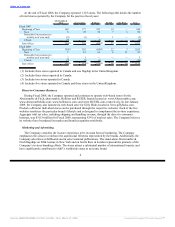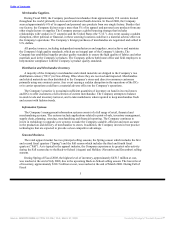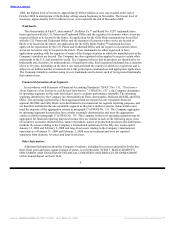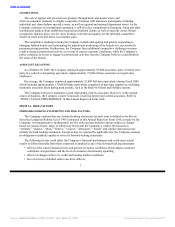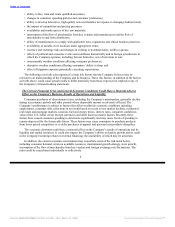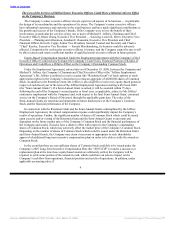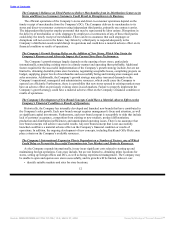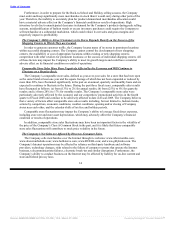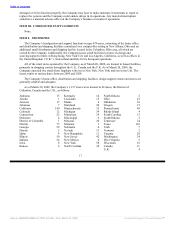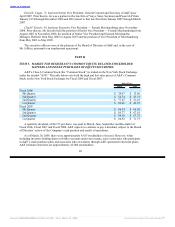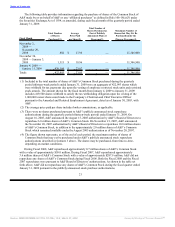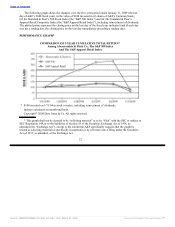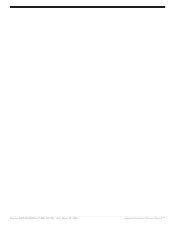Abercrombie & Fitch 2008 Annual Report Download - page 16
Download and view the complete annual report
Please find page 16 of the 2008 Abercrombie & Fitch annual report below. You can navigate through the pages in the report by either clicking on the pages listed below, or by using the keyword search tool below to find specific information within the annual report.
Table of Contents
Furthermore, in order to prepare for the Back-to-School and Holiday selling seasons, the Company
must order and keep significantly more merchandise in stock than it would carry during other parts of the
year. Therefore, the inability to accurately plan for product demand and merchandise allocation could
have a material adverse effect on the Company’s financial condition or results of operations. High
inventory levels due to unanticipated decreases in demand for the Company’s products during peak selling
seasons, misidentification of fashion trends or excess inventory purchases could require the Company to
sell merchandise at a substantial markdown, which could reduce its net sales and gross margins and
negatively impact its profitability.
The Company’s Ability to Attract Customers to its Stores Depends Heavily on the Success of the
Shopping Centers in Which They are Located.
In order to generate customer traffic, the Company locates many of its stores in prominent locations
within successful shopping centers. The Company cannot control the development of new shopping
centers; the availability or cost of appropriate locations within existing or new shopping centers;
competition with other retailers for prominent locations; or the success of individual shopping centers. All
of these factors may impact the Company’s ability to meet its growth targets and could have a material
adverse effect on its financial condition or results of operations.
Comparable Store Sales Have Been Negatively Affected by the Economy and Will Continue to
Fluctuate on a Regular Basis.
The Company’s comparable store sales, defined as year-over-year sales for a store that has been open
as the same brand at least one year and the square footage of which has not been expanded or reduced by
more than 20%, have fluctuated significantly in the past on an annual, quarterly and monthly basis and are
expected to continue to fluctuate in the future. During the past three fiscal years, comparable sales results
have fluctuated as follows: (a) from (13%) to 2% for annual results; (b) from (25%) to 6% for quarterly
results; and (c) from (28%) to 17% for monthly results. The Company’s comparable store sales were
particularly adversely affected by the economy and our competitors’ promotional activities in the fourth
quarter of Fiscal 2008 and continue to be adversely affected to date in Fiscal 2009. The Company believes
that a variety of factors affect comparable store sales results including, but not limited to, fashion trends,
actions by competitors, economic conditions, weather conditions, opening and/or closing of Company
stores near each other, and the calendar shifts of tax free and holiday periods.
Comparable store fluctuations may impact the Company’s ability to leverage fixed direct expenses,
including store rent and store asset depreciation, which may adversely affect the Company’s financial
condition or results of operations.
In addition, comparable store sales fluctuations may have been an important factor in the volatility of
the price of the Company’s Class A Common Stock in the past, and it is likely that future comparable
store sales fluctuations will contribute to stock price volatility in the future.
The Company’s Net Sales are Affected by Direct-to-Consumer Sales.
The Company sells merchandise over the Internet through its websites: www.Abercrombie.com;
www.abercrombiekids.com; www.hollisterco.com; www.RUEHL.com; and www.gillyhicks.com. The
Company’s Internet operations may be affected by reliance on third-party hardware and software
providers, technology changes, risks related to the failure of computer systems that operate the Internet
business, telecommunications failures, electronic break-ins and similar disruptions. Furthermore, the
Company’s ability to conduct business on the Internet may be affected by liability for on-line content and
state and federal privacy laws.
14
Source: ABERCROMBIE & FITCH CO /DE/, 10-K, March 27, 2009 Powered by Morningstar® Document Research℠


